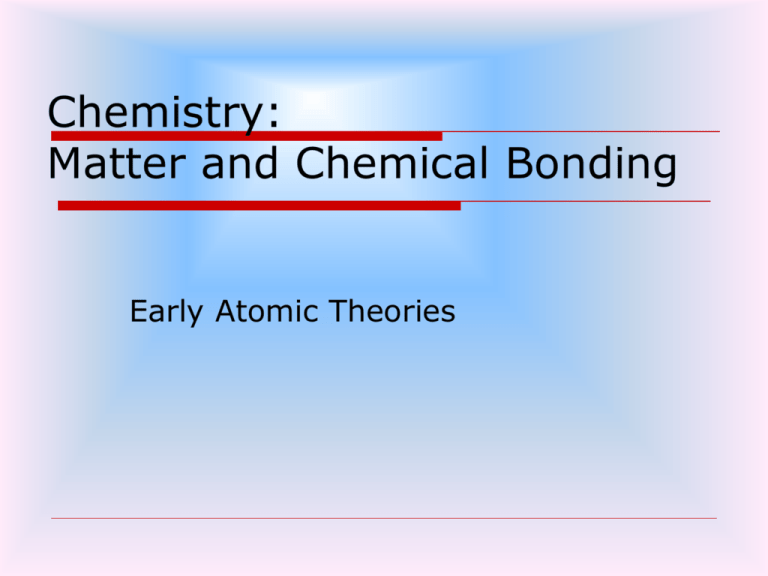SNC1D0 Atomic History
advertisement

Chemistry: Matter and Chemical Bonding Early Atomic Theories Timeline. . . . . Ancient Greeks (approx 450 BC) "Four Element" Theory – Earth, Air, Fire, Water Benefits: First suggestion that substances were actually made up of a combination of different "elements." Democritus: 400 BC – Democritus "The smallest indivisible particle of matter is the 'atom' " No evidence – based on thought However, the "4 element" theory lingered for almost 2000 years! (YIKES) Democritus’ Model John Dalton (1809) All matter is composed of indivisible particles called atoms. All atoms of a given element are identical; atoms of different elements have different properties. Chemical reactions involve the combination of atoms, not the destruction of atoms. When elements react to form compounds, they react in whole-number ratios. Dalton's atomic theory supported previous research. Lasted almost a century! Model: Indivisible billiard ball J.J. Thomson (1897) Used the work of other scientists that showed that atoms contain charges, and his own work with cathode ray tubes, to develop a modified atomic theory. Atoms are positive spheres, with negative particles (electrons) embedded in them. Model: Raisin bun Ernest Rutherford (1911) Student of Thomson – disagreed. Gold Foil Experiment: Alpha radiation (positive) were shot at a piece of gold foil. Most of the alpha particles passed through the foil, suggesting that most of matter is empty space! Some particles were deflected back at angles; they had come in contact with something very dense! Gold Foil Experiment: Leading to…..Nuclear Model: Rutherford – dense core of positive charge (nucleus), with negative electrons orbiting around the nucleus. Later experiments showed that the positively charged particles, now called protons, have an equal but opposite charge to the electrons, and have a mass 1836 x greater! The neutron and the existence of isotopes were also discovered Niels Bohr Worked with Rutherford Used atomic spectrum information to place electrons in energy levels around the nucleus Spectroscope: How it works…. Each element has a unique emission spectrum When electrons are given energy, they jump to a new energy level When they fall back down, they emit this extra energy as light Lines on an emission spectrum represent jumps between energy levels. DEMO Emission Spectra: Modern View of the Atom Dense nucleus containing: (+) protons Neutral neutrons Shells of small (-) electrons orbiting the nucleus 2 e- in 1st orbital 8 in 2nd 8 in 3rd (until next year) Subatomic Charge Particle Location Size Proton (p+) Positive Nucleus 1 Neutron (n0) Neutral Nucleus 1 Electron (e-) Negative In Orbit 1_ 2000 Atomic Number = # of protons = # of electrons in a neutral atom Atomic mass / Mass Number -Use rounded values -26.98 -> 27 Mass number = protons + neutrons -28.09 -> 28 -30.97 -> 31 Isotopes Atoms of the same element have the same # of protons The # of neutrons can differ The same element with a different # of neutrons are called isotopes Radioisotopes are unstable and decay creating radioactivity Average atomic mass takes the masses of all isotopes into account. Standard Atomic Notation C 12 6 mass # is 12 atomic # is 6 therefore, this carbon has 12 - 6 = 6 neutrons GROUPS ON THE PERIODIC TABLE Your Turn Subatomic Particle Worksheet Read 6.4 Define: Chemical Family, Periods, Dmitri Mendeleev “Try this” on page 224 Homework P. 225 Q: 1-6, 8-11





